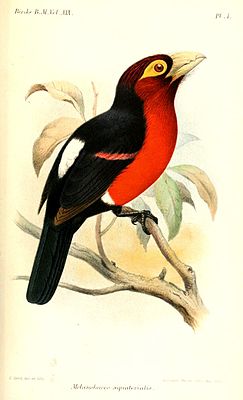Double-toothed bearded bird
| Double-toothed bearded bird | ||||||||||
|---|---|---|---|---|---|---|---|---|---|---|

Double-toothed bearded bird ( Lybius bidentatus ) |
||||||||||
| Systematics | ||||||||||
|
||||||||||
| Scientific name | ||||||||||
| Lybius bidentatus | ||||||||||
| ( Shaw , 1798) |
The double-toothed bearded bird ( Lybius bidentatus ) is a species from the African bearded bird family . The species occurs in Africa on both sides of the equator. Several subspecies are distinguished. The IUCN classifies the double-toothed bearded bird as not endangered ( least concern ).
Appearance
The males of the nominate form reach a wing length of 9.7 to 10.4 centimeters. The tail length is 7.3 to 8.4 centimeters. The beak is between 2.8 and 3.3 inches long. The double-toothed bearded bird is one of the largest species within the tooth bearded species. Females have similar body measurements. The sexual dimorphism is only slightly pronounced.
The males have a black forehead and a black skull, both slightly interspersed with red. Otherwise, the top of the body is black from the crown to the control feathers, they only have a small white or white and red spot on the lower back. The sides of the face and the chin are black, the cheeks, the sides of the neck, the throat and the chest are red, with the black feather bases partially visible. The abdomen and sides of the body are also black. A white spot separates the red sides of the body from the black flanks. The under tail-coverts are also black. The feathered skin around the eyes is yellow, the eyes are yellow to brown or brownish red. The legs and feet are brown.
Females are largely similar to males, but have small, fine black lines on the red sides of the body, some of which are also visible on the white patch on the side. Young birds are similar to adults, but have duller plumage overall. The red is less bright, the black is less shiny.
It can only be confused with the Senegal furry beak and the black breast furrowed beak . However, the Senegal furrowbill has a black chest band, the black breast furrowbill has a black chin, black throat, and black chest. The featherless skin around the eyes is bluish-slate in color.
Distribution area
The distribution area of the double-toothed bearded bird extends from Guinea-Bissau , Sierra Leone and northern Liberia to the south of Nigeria , Cameroon , the south of the Central African Republic and Sudan and Ethiopia . In the southern direction of distribution it occurs in Angola , the Republic of the Congo , the north and northeast of the Democratic Republic of the Congo , Burundi , the northwest of Tanzania and the west of Kenya .
Double-toothed bearded birds are forest dwellers, but they are absent in the extensive forest areas of the Democratic Republic of the Congo and Gabon . The altitude distribution ranges from sea level to altitudes of 2,300 meters.
Way of life
The double-toothed bearded bird prefers forests with dense undergrowth and prefers to stay near forest edges or clearings. It also colonizes secondary forests and dense, isolated, small forest remains and tree plantations. It lives in pairs or in small flocks, which are either parent birds with young birds or parent birds with fully grown but not yet mated offspring. These take on the role of a helper.
While foraging for food they stay in the dense undergrowth and are therefore often not to be seen. Their food spectrum consists of fruits and insects. Some insects are also found in the air. The fruits eaten include papayas and avocados, as well as the berries of the poka bush introduced in Africa . Double-toothed bearded birds show a clear reaction to the vocalizations of the yellow-billed bearded bird , which is one of the ornamental bearded birds.
Double-toothed bearded birds, like almost all bearded birds, are cave-breeders. The nest holes are hacked into dead tree trunks or branches at a height of at least two meters above the ground. The cave entrance has a diameter of five centimeters. Both the breeding pair and the helpers defend the nest cavity against nesting competitors such as the red-billed maggot chopper or breeding parasites such as the small honey indicator .
The clutch consists of two to four eggs. The breeding season is 13 days. Freshly hatched young birds are first fed with insects and then increasingly receive fruit. The nestling period is 37 to 39 days.
supporting documents
literature
- Lester L. Short, Jennifer FM Horne: Toucans, Barbets and Honeyguides - Ramphastidae, Capitonidae and Indicatoridae . Oxford University Press, Oxford 2001, ISBN 0-19-854666-1
Individual evidence
- ↑ Pogonornis bidentatus in the IUCN Red List of Threatened Species 2010.4. Listed by: BirdLife International, 2009. Retrieved March 25, 2011.
- ↑ Short et al., P. 216
- ↑ Short et al., P. 217
- ↑ Short et al., P. 218
